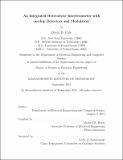| dc.contributor.advisor | Michael R. Watts. | en_US |
| dc.contributor.author | Cole, David B. (David Bernard) | en_US |
| dc.contributor.other | Massachusetts Institute of Technology. Department of Electrical Engineering and Computer Science. | en_US |
| dc.date.accessioned | 2016-03-03T20:30:28Z | |
| dc.date.available | 2016-03-03T20:30:28Z | |
| dc.date.copyright | 2015 | en_US |
| dc.date.issued | 2015 | en_US |
| dc.identifier.uri | http://hdl.handle.net/1721.1/101469 | |
| dc.description | Thesis: Sc. D., Massachusetts Institute of Technology, Department of Electrical Engineering and Computer Science, 2015. | en_US |
| dc.description | This electronic version was submitted by the student author. The certified thesis is available in the Institute Archives and Special Collections. | en_US |
| dc.description | Cataloged from PDF version of thesis. | en_US |
| dc.description | Includes bibliographical references (pages 201-206). | en_US |
| dc.description.abstract | The application of CMOS processing techniques developed in the microelectronics world to that of silicon photonics has been the catalyst for the rapid proliferation of smaller, higher performance, and more densely integrated photonic devices that are rapidly advancing the field with large-scale implementations of photonic systems. It is only logical that as the silicon photonics library continues to grow, that these devices will be synthesized into complete systems for applications including optical networking and communications, imaging, and sensors. Among complex optical systems, the interferometer represents perhaps the most important class of optical sensors and scientific instruments ever developed. Today, interferometric techniques are key to applications such as displacement measurement, photolithography, vibrometry, optical coherence tomography (OCT), and LIDAR. In these applications, the preferred mode is the heterodyne interferometer. However, modern heterodyne interferometers are complex systems requiring bulk optical devices to be implemented. As a result, they are large and expensive precision instruments limited to industrial and scientific applications. The development of a chip-scale integrated interferometer, with its significantly smaller form factor, increased stability, and lower cost, could greatly expand the application of interferometric techniques. Leveraging silicon photonics, the required components can be realized on-chip, allowing for a low-cost, high-precision interferometer to be implemented. In this thesis, the design and experimental results of the first silicon chip-scale heterodyne interferometer is presented. The device is constructed of a series of on-chip beam-splitters, modulators, and germanium detectors in a Michelson-like configuration. The interferometer achieves a noise-limited position resolution of approximately 2 nm in a 1 mm by 6 mm footprint. The vibrometer and LIDAR modes; two modalities with important scientific, industrial, and consumer applications, are also demonstrated. | en_US |
| dc.description.statementofresponsibility | by David B. Cole. | en_US |
| dc.format.extent | 206 pages | en_US |
| dc.language.iso | eng | en_US |
| dc.publisher | Massachusetts Institute of Technology | en_US |
| dc.rights | M.I.T. theses are protected by copyright. They may be viewed from this source for any purpose, but reproduction or distribution in any format is prohibited without written permission. See provided URL for inquiries about permission. | en_US |
| dc.rights.uri | http://dspace.mit.edu/handle/1721.1/7582 | en_US |
| dc.subject | Electrical Engineering and Computer Science. | en_US |
| dc.title | An integrated heterodyne interferometer with on-chip detectors and modulators | en_US |
| dc.type | Thesis | en_US |
| dc.description.degree | Sc. D. | en_US |
| dc.contributor.department | Massachusetts Institute of Technology. Department of Electrical Engineering and Computer Science | |
| dc.identifier.oclc | 940811488 | en_US |
